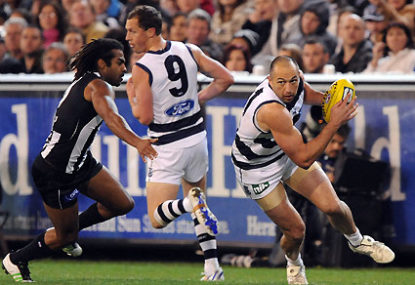Last weekend the AFL held its third US combine, a try out for American athletes who think they may have something to offer our great Australian game.
The combine is attended by recruiters from AFL clubs in the hope that they may discover the next big thing, but in all reality, they will probably come away with very little. Of course there is no harm in looking, but is the time and effort – not to mention the cost – of putting on the combine actually worth it?
Does the AFL really think that the exercise will pay dividends?
Gaelic footballers aside, very few others have made their way to the top levels of our sport from other avenues. Big Swan Mike Pyke is the obvious exception, having played rugby in France and for his home country Canada. He is now a premiership hero and deserves the rewards that have come his way.
Setanta O’hAilpin is another to have entered the AFL in a roundabout fashion. Starting with the Blues and finishing up at the Giants, the big Irishman excelled at hurling, that bizarre sport which somehow seems to combine hockey, football and lacrosse into something that works.
While both Pyke and O’hAilpin have played some solid football for their respective clubs, neither would be considered a superstar. As Jack Dyer would say, they are “good, ordinary footballers”.
Of the others, Karmichael Hunt played some decent games for the Suns after a slow start, but hardly justified the money that was spent on him, while the less said about Israel Folau the better. While their recruitment from rugby league was as much about promotion as potential, it remains debatable whether they even delivered on that score.
So what can we expect from the American experiment?
According to the United States Australian Football League website, recruiters are looking for (drumroll please) the next Eric Wallace, Jason Holmes or Patrick Mitchell.
(Sound of crickets.)
Give yourself a pat on the back if you have heard of even one of these names, but don’t beat yourself up if you haven’t.
The big three have been recruited from previous combines, making it all the way to the heady heights of a club international rookie list (yes, there is such a thing).
Wallace is listed to North Melbourne, Holmes to St. Kilda and Mitchell to Sydney. All come from basketball backgrounds as do most of this year’s combine participants.
In fact, the shortest of the twenty names to line-up at this year’s try-outs was a handy 198 centimetres. The majority stand at well over two metres, the tallest matching Aaron Sandilands’ 211 centimetres.
No doubt each has been picked for his athletic prowess. They can probably run faster, jump higher and have more freakish agility than most of the sporting population, but in the context of a chaotic, sometimes haphazard sport such as Australian Rules, does this really matter?
After all, it doesn’t matter how high you can jump if you can’t get your hands on the pill.
Yes, footy is an athletic game, but being the best athlete doesn’t necessarily mean you will be the best footballer. Athletes can become good footballers, but the best footballers are footballers first.
The prime example is two-time Brownlow medallist Greg ‘Diesel’ Williams. Under current athletic testing, the former Geelong and Carlton champion would probably not have made it through draft camp.
What a loss to the game that would have been.
While it is alright for recruiters to explore other options and try to develop alternative pools of talent from which to draw, sometimes there is more value in looking closer to home.
Over the past few years, dramatic draft concessions to start-up clubs Gold Coast and Greater Western Sydney forced rival recruiters to look beyond the usual TAC Cup junior competition for potential players.
A bountiful harvest of mature-aged recruits were plucked from state leagues, ready-made players eager to prove that time had not passed them by. Physically ready for the rigours of senior AFL footy and well versed in the game’s rhythms and subtleties, these players were a coach’s dream.
Led by former Cat (now Crow) James Podsiadly, this once-underrated Dad’s Army have proved a revelation. They represent a cheaper, less time-consuming way to bolster a club’s list, bringing experience and footy smarts that younger players – and internationals – lack.
Perhaps it is time once again to turn our eyes to footy’s heartlands, scouring the metropolitan and country leagues for the talent that exists within. These unheralded players might not be able to smash the AFL’s infamous beep test or jump over a cow, but they do eat footballs for breakfast and love the game.
More importantly they know how to get the pill.
While the so-called expansion into overseas markets is a good publicity exercise for the AFL, there seems to be little value in investing huge sums of money into good, ordinary players.
In the early 1980s, then-Essendon coach Kevin Sheedy trialled an American gridiron player in a pre-season practice game. His only possession resulted in a free kick to the opposition. Like Forrest Gump, he had picked up the ball and just kept on running. Who’d have thought that you had to bounce the confounded thing?
He was never heard of again.
Odds are that this latest batch of internationals will suffer the same fate.





























































































